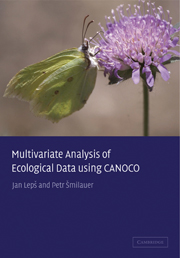Book contents
- Frontmatter
- Contents
- Preface
- 1 Introduction and data manipulation
- 2 Experimental design
- 3 Basics of gradient analysis
- 4 Using the Canoco for Windows 4.5 package
- 5 Constrained ordination and permutation tests
- 6 Similarity measures
- 7 Classification methods
- 8 Regression methods
- 9 Advanced use of ordination
- 10 Visualizing multivariate data
- 11 Case study 1: Variation in forest bird assemblages
- 12 Case study 2: Search for community composition patterns and their environmental correlates: vegetation of spring meadows
- 13 Case study 3: Separating the effects of explanatory variables
- 14 Case study 4: Evaluation of experiments in randomized complete blocks
- 15 Case study 5: Analysis of repeated observations of species composition from a factorial experiment
- 16 Case study 6: Hierarchical analysis of crayfish community variation
- 17 Case study 7: Differentiating two species and their hybrids with discriminant analysis
- Appendix A Sample datasets and projects
- Appendix B Vocabulary
- Appendix C Overview of available software
- References
- Index
6 - Similarity measures
Published online by Cambridge University Press: 09 February 2010
- Frontmatter
- Contents
- Preface
- 1 Introduction and data manipulation
- 2 Experimental design
- 3 Basics of gradient analysis
- 4 Using the Canoco for Windows 4.5 package
- 5 Constrained ordination and permutation tests
- 6 Similarity measures
- 7 Classification methods
- 8 Regression methods
- 9 Advanced use of ordination
- 10 Visualizing multivariate data
- 11 Case study 1: Variation in forest bird assemblages
- 12 Case study 2: Search for community composition patterns and their environmental correlates: vegetation of spring meadows
- 13 Case study 3: Separating the effects of explanatory variables
- 14 Case study 4: Evaluation of experiments in randomized complete blocks
- 15 Case study 5: Analysis of repeated observations of species composition from a factorial experiment
- 16 Case study 6: Hierarchical analysis of crayfish community variation
- 17 Case study 7: Differentiating two species and their hybrids with discriminant analysis
- Appendix A Sample datasets and projects
- Appendix B Vocabulary
- Appendix C Overview of available software
- References
- Index
Summary
In many multivariate methods, one of the first steps is to calculate a matrix of similarities (resemblance measures) either between the samples (relevés) or between the species. Although this step is not explicitly done in all the methods, in fact each of the multivariate methods works (even if implicitly) with some resemblance measure. The linear ordination methods can be related to several variants of Euclidean distance, while the weighted-averaging ordination methods can be related to chi-square distances. There semblance functions are reviewed in many texts (e.g. Gower & Legendre 1986; Legendre & Legendre 1998; Ludwig & Reynolds 1988; Orloci 1978), so here we will introduce only the most important ones.
In this chapter, we will use the following notation: we have n samples (relevés), containing m species. Yik represents the abundance of the kth species (k = 1, 2, …,m) in the ith sample (i = 1, 2, …, n).
It is technically possible to transpose the data matrix (or exchange i and k in the formulae), thus any of the resemblance functions can be calculated equally well for rows or columns (i.e. for samples or species). Nevertheless, there are generally different kinds of resemblance functions suitable for expressing the (dis)similarity among samples, and those suitable for describing similarity among the species. This is because the species set is usually a fixed entity: if we study vascular plants, then all the vascular plants in any plot are recorded – or at least we believe we have recorded them. But the sample set is usually just a (random) selection, something which is not fixed.
- Type
- Chapter
- Information
- Multivariate Analysis of Ecological Data using CANOCO , pp. 76 - 95Publisher: Cambridge University PressPrint publication year: 2003
- 2
- Cited by



